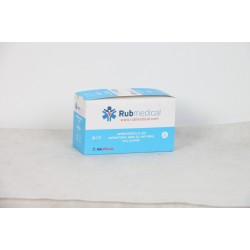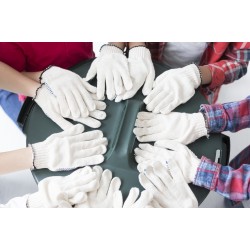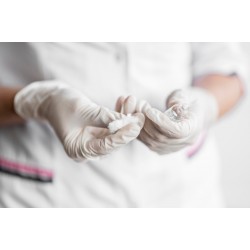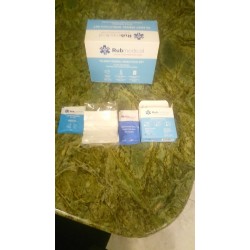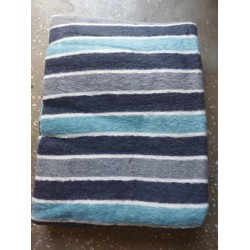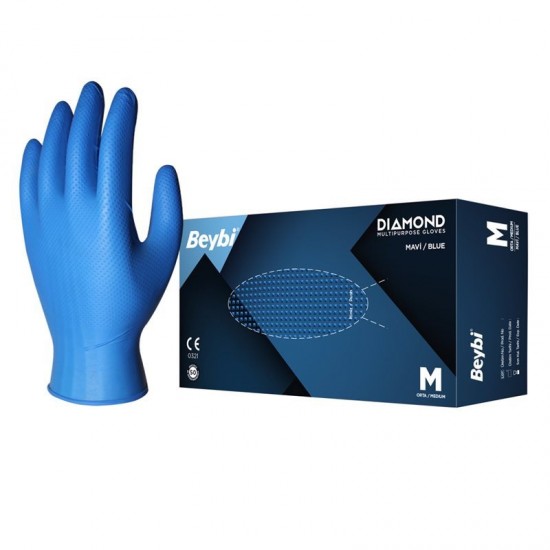
When it comes to examination gloves, selecting the right type of latex gloves is crucial. Not only do these gloves serve as a protective barrier, but they also ensure the safety and well-being of both the healthcare professional and the patient. In this comprehensive guide, we will explore the essential factors to consider when choosing the perfect latex gloves for examination purposes, providing you with all the necessary information to make an informed decision.
Comfort and Fit: One of the primary aspects to consider when selecting latex gloves is their comfort and fit. It is essential to choose gloves that offer a snug fit to prevent hand fatigue and ensure optimal dexterity. Gloves that are too loose may hinder movement and compromise the precision required during examinations.
Quality and Durability: Another crucial factor to keep in mind is the quality and durability of the latex gloves. High-quality gloves are manufactured using premium latex materials, ensuring their reliability and resistance to tearing or puncturing. By investing in durable gloves, you can be confident in their ability to withstand rigorous examination procedures without compromising safety.
Sensitivity and Tactility: Sensitivity and tactility are vital when it comes to examination gloves. The gloves should provide a high level of sensitivity, allowing the healthcare professional to accurately feel and manipulate small objects during examinations. Opting for gloves that offer a natural feel can significantly enhance the examination experience for both the professional and the patient.
Powdered or Powder-Free: Latex gloves are available in both powdered and powder-free variations. While powdered gloves are easier to put on and remove, some individuals may have allergies or sensitivities to the powder. In such cases, it is recommended to choose powder-free gloves to minimize the risk of adverse reactions.
Ambidextrous Design: Consider selecting gloves with an ambidextrous design. These gloves can be worn on either hand, eliminating the need to worry about whether the glove is meant for the left or right hand. Not only does this simplify the process of wearing gloves but it also minimizes the risk of mix-ups during hectic examination scenarios.
Proper Sizing: Ensuring the correct sizing is crucial for the effectiveness and comfort of latex gloves. Gloves that are too small may cause hand fatigue, restrict movement, and increase the likelihood of tears. On the other hand, oversized gloves may slip off during critical moments. Carefully measure the hand size and refer to the manufacturer's sizing chart to select the most appropriate fit.
Standards and Certifications: When choosing latex gloves, it is important to opt for products that meet industry standards and certifications. Look for gloves that are tested and approved by reputable organizations to ensure they meet the necessary requirements for examination purposes. This provides assurance in the quality and reliability of the gloves.
By considering these essential factors, you can confidently choose the right latex gloves for examination purposes. Remember to prioritize comfort, fit, quality, and sensitivity, while also taking into account powdered or powder-free preferences, ambidextrous design, proper sizing, and industry certifications. This comprehensive guide aims to assist healthcare professionals in making an informed decision, ultimately promoting safety, efficiency, and the well-being of both the professional and the patient.
Key Factors to Consider When Selecting a Latex Gloves Manufacturer
When it comes to selecting a latex gloves manufacturer, there are several key factors that you should consider. Whether you are purchasing gloves for medical, industrial, or personal use, making the right choice is crucial for ensuring quality and safety. In this article, we will discuss the important factors to keep in mind when choosing a latex gloves manufacturer.
Quality: The quality of the latex gloves should be your top priority. Look for a manufacturer that follows strict quality control processes and adheres to international standards. Check if they have certifications such as ISO or FDA, which indicate their commitment to maintaining high-quality products. High-quality gloves not only provide better protection but also offer greater comfort and durability.
Production Capacity: Another important factor to consider is the production capacity of the manufacturer. Ensure that they have the capability to meet your requirements, whether you need gloves in small quantities or large bulk orders. Manufacturing delays or low production capacity can lead to supply shortages, which can be detrimental to your business or organization.
Range of Products: Consider the range of latex gloves offered by the manufacturer. It is beneficial to choose a manufacturer that provides a wide variety of gloves to suit different needs. This includes options such as powdered or powder-free gloves, different sizes, and various thickness levels. Having a diverse range of products allows you to select gloves that best meet your specific requirements.
Price: Price is a crucial factor when selecting a latex gloves manufacturer, especially if you are buying in bulk. Compare prices from different manufacturers to ensure that you are getting the best value for your money. However, keep in mind that the cheapest option may not always be the most reliable or of the highest quality. Balance cost with quality to make an informed decision.
- Customer Reviews: Reading customer reviews and testimonials can provide valuable insights into the reputation and reliability of the manufacturer. Look for positive feedback regarding product quality, customer service, and timely delivery. Avoid manufacturers with a history of negative reviews or complaints.
- Customization: Depending on your specific requirements, you may need customized latex gloves. In such cases, it is essential to choose a manufacturer that offers customization options. This includes the ability to add logos, change colors, or modify design elements. Customization allows you to create gloves that align with your branding or specific industry needs.
- Environmental Considerations: Sustainability and environmental responsibility are increasingly important factors when selecting any manufacturer. Look for manufacturers that prioritize eco-friendly manufacturing processes and use biodegradable materials. This not only reduces the environmental impact but also demonstrates their commitment to ethical practices.
In conclusion, selecting a latex gloves manufacturer requires careful consideration of various factors. Prioritize quality, check production capacity, assess the range of products offered, compare prices, and consider customer reviews. Customization options and environmental considerations are also important aspects to keep in mind. By selecting a reputable manufacturer, you can ensure the safety and satisfaction of your customers or users.
The Importance of Quality Control in Latex Gloves Manufacturing
Quality control is a crucial aspect of latex gloves manufacturing. Ensuring that every pair of gloves meets the highest standards of quality is essential for both manufacturers and end-users. In this article, we will explore the significance of quality control in the manufacturing process and the key steps involved in maintaining the highest standards.
Latex gloves are widely used in various industries, including healthcare, food service, and laboratories, due to their excellent barrier properties and tactile sensitivity. As these gloves come into close contact with human skin, it is imperative that they are free from defects and contaminants that could compromise the safety and effectiveness of their use.
One of the primary reasons why quality control is vital in latex gloves manufacturing is to ensure the absence of defects, such as holes, tears, or weak spots. These manufacturing defects can render the gloves ineffective and increase the risk of contamination, which is particularly concerning in healthcare settings where the transmission of infectious diseases must be minimized.
To maintain the highest standards of quality, manufacturers must implement strict quality control procedures throughout the manufacturing process. This includes rigorous inspection of raw materials, such as latex, to ensure their purity and suitability for glove production. Additionally, the manufacturing equipment should be regularly calibrated and monitored to minimize variations and defects.
Furthermore, quality control measures should be implemented at different stages of the manufacturing process, including the dipping, drying, and curing processes. This involves conducting regular quality checks to detect any deviations from the set parameters and taking corrective actions promptly. By identifying and rectifying issues early on, manufacturers can prevent the production of defective gloves and reduce wastage.
In addition to defect detection, quality control also plays a vital role in ensuring the gloves meet the required standards for physical properties and performance. This includes evaluating factors such as tensile strength, elongation, thickness, and barrier integrity. By conducting comprehensive testing, manufacturers can have confidence in the reliability and effectiveness of their gloves.
Another critical aspect of quality control is compliance with various regulatory standards and certifications. Different countries and industries have specific requirements for glove manufacturing, such as the Food and Drug Administration (FDA) regulations in the United States. Manufacturers must adhere to these standards to ensure that their gloves are safe for use and meet the necessary quality benchmarks.
| Benefits of Quality Control in Latex Gloves Manufacturing |
|---|
| 1. Ensures the production of high-quality gloves that are free from defects and contaminants. |
| 2. Reduces the risk of contamination and transmission of infectious diseases. |
| 3. Enhances customer satisfaction by providing reliable and effective gloves. |
| 4. Minimizes wastage by preventing the production of defective gloves. |
| 5. Ensures compliance with regulatory standards and certifications. |
In conclusion, quality control is of utmost importance in latex gloves manufacturing. By implementing robust quality control procedures, manufacturers can ensure the production of high-quality gloves that meet the necessary standards for safety and performance. Compliance with regulatory requirements is crucial to gain trust and confidence from end-users. Ultimately, quality control plays a vital role in protecting the health and well-being of individuals who rely on latex gloves for various applications.
Understanding the Different Types of Latex Gloves for Examination
Latex gloves are commonly used in medical and laboratory settings for examination purposes. They are known for their superior quality and barrier protection against various substances. However, not all latex gloves are created equal. There are different types of latex gloves available, each with its own unique characteristics and purposes.
1. Powdered Latex Gloves:
- These gloves are coated with a fine powder, typically cornstarch, to make them easier to don and remove.
- They provide excellent tactile sensitivity and grip, making them suitable for delicate procedures.
- However, powdered latex gloves can potentially cause allergic reactions in some individuals.
2. Powder-Free Latex Gloves:
- These gloves are free from powder, eliminating the risk of powder-related allergies.
- They offer a snug and comfortable fit, ensuring maximum dexterity during examinations.
- Powder-free latex gloves are suitable for individuals with latex allergies or sensitivities.
3. Micro-Textured Latex Gloves:
- These gloves feature a micro-textured surface, providing enhanced grip and control.
- They are commonly used in procedures that require a firm grasp, such as surgeries.
- The micro-textured design minimizes the risk of slippage and ensures precision.
4. Extended Cuff Latex Gloves:
- These gloves have an extended cuff that provides additional protection for the wrists and lower forearm.
- They are suitable for situations where there is a risk of exposure to hazardous substances.
- Extended cuff latex gloves are commonly used in chemical laboratories and industrial settings.
It is important to choose the right type of latex gloves based on the specific needs of the examination. Factors such as sensitivity, grip, allergies, and potential exposure to hazardous substances should be taken into consideration when selecting the appropriate gloves. By understanding the different types of latex gloves available, healthcare professionals can ensure the safety and well-being of both themselves and their patients.
In conclusion, the range of latex gloves for examination purposes is broad. From powdered and powder-free options to micro-textured and extended cuff variations, there is a glove to suit every need. Choosing the right gloves ensures optimal protection, comfort, and precision during medical and laboratory procedures. Remember to consider the specific requirements of each situation and prioritize the safety of both healthcare professionals and patients.
Common Questions and Answers About Latex Gloves for Examination
Latex gloves are widely used in the medical field for examination purposes. These gloves provide a protective barrier between healthcare professionals and patients, helping to prevent the spread of infections. In this article, we will address some common questions and provide answers about latex gloves for examination.
1. What are latex gloves?
Latex gloves are disposable gloves made from natural rubber latex. They are flexible, comfortable to wear, and offer excellent tactile sensitivity, making them ideal for medical professionals who need dexterity in their hands.
2. Are latex gloves safe to use?
Latex gloves are generally safe to use, but some individuals may develop an allergic reaction to latex proteins. This allergic reaction can range from mild skin irritation to severe respiratory distress. It is important for healthcare professionals to be aware of latex allergies and use alternative glove materials if necessary.
3. How do latex gloves compare to other glove materials?
Latex gloves have several advantages over other glove materials. They provide superior barrier protection against bacteria, viruses, and chemicals. Latex gloves also offer excellent elasticity and a snug fit, reducing the risk of glove slip or tear during examination procedures.
4. Can latex gloves be recycled?
Latex gloves are not easily recyclable due to the presence of latex proteins. However, some manufacturers have developed recycling programs for latex gloves to minimize environmental impact. It is recommended to check with your local recycling facilities for proper disposal options.
5. Where can I purchase latex gloves?
Latex gloves are widely available at medical supply stores, pharmacies, and online retailers. It is important to choose gloves that meet quality standards and are approved for medical use. Always check for the appropriate certifications and labels to ensure the gloves are safe for examination purposes.
6. How should latex gloves be stored?
Latex gloves should be stored in a cool, dry place away from direct sunlight and excessive heat. Exposure to sunlight and heat can cause the latex material to deteriorate and lose its protective qualities. It is also important to check the expiration date before using latex gloves to ensure their effectiveness.
| Question | Answer |
|---|---|
| 1. What are latex gloves? | Latex gloves are disposable gloves made from natural rubber latex. They are flexible, comfortable to wear, and offer excellent tactile sensitivity, making them ideal for medical professionals who need dexterity in their hands. |
| 2. Are latex gloves safe to use? | Latex gloves are generally safe to use, but some individuals may develop an allergic reaction to latex proteins. This allergic reaction can range from mild skin irritation to severe respiratory distress. It is important for healthcare professionals to be aware of latex allergies and use alternative glove materials if necessary. |
| 3. How do latex gloves compare to other glove materials? | Latex gloves have several advantages over other glove materials. They provide superior barrier protection against bacteria, viruses, and chemicals. Latex gloves also offer excellent elasticity and a snug fit, reducing the risk of glove slip or tear during examination procedures. |
| 4. Can latex gloves be recycled? | Latex gloves are not easily recyclable due to the presence of latex proteins. However, some manufacturers have developed recycling programs for latex gloves to minimize environmental impact. It is recommended to check with your local recycling facilities for proper disposal options. |
| 5. Where can I purchase latex gloves? | Latex gloves are widely available at medical supply stores, pharmacies, and online retailers. It is important to choose gloves that meet quality standards and are approved for medical use. Always check for the appropriate certifications and labels to ensure the gloves are safe for examination purposes. |
| 6. How should latex gloves be stored? | Latex gloves should be stored in a cool, dry place away from direct sunlight and excessive heat. Exposure to sunlight and heat can cause the latex material to deteriorate and lose its protective qualities. It is also important to check the expiration date before using latex gloves to ensure their effectiveness. |
In conclusion, latex gloves are a crucial component in maintaining a safe and hygienic environment in the medical field. Understanding their characteristics, potential risks, and proper usage is essential for healthcare professionals. Always prioritize safety and opt for alternative glove materials if allergic reactions are a concern. By following appropriate storage and disposal practices, we can ensure the effectiveness and efficiency of latex gloves for examination purposes.
For more information on latex gloves, you can refer to the (Latex Gloves for Examination Wikipedia page).
Frequently Asked Questions
Latex gloves are commonly used in medical and healthcare settings for examination purposes. They provide a protective barrier between the wearer and potential contaminants.
No, latex gloves are not suitable for individuals with latex allergies. Latex allergies can cause adverse reactions and discomfort for those who are sensitive to latex. In such cases, alternative glove options should be considered, such as nitrile or vinyl gloves.
Latex gloves are typically disposable and not intended for reuse. They should be discarded after each use to prevent the spread of germs and maintain proper hygiene standards.
Latex gloves should be stored in a cool, dry place away from direct sunlight, heat sources, and chemicals. Exposure to such elements can cause premature deterioration and compromise the gloves' integrity.
Latex gloves are available in various sizes to ensure a proper and comfortable fit. Common sizes include small, medium, large, and extra-large. It is important to choose the appropriate size to maintain dexterity and performance during glove usage.
Latex gloves have some level of chemical resistance, but their effectiveness may vary depending on the specific chemicals involved. It is advisable to consult the glove manufacturer's specifications or conduct compatibility tests to ensure suitable protection against specific chemicals.
Latex gloves are generally not recommended for direct contact with food. In certain circumstances, the use of powder-free, low-protein latex gloves may be acceptable, but it is important to comply with local regulations and guidelines regarding gloves for food handling.
Some advantages of latex gloves include their superior tactile sensitivity, elasticity, and fit. Latex gloves conform well to the hand, providing excellent dexterity and tactile feedback, which is crucial in medical and examination settings.
Natural latex gloves are biodegradable, as latex is derived from the sap of rubber trees. However, the manufacturing process and additional treatments may affect the biodegradability of latex gloves. It is recommended to check with the glove manufacturer for specific information.
Latex gloves are generally not recommended for handling chemotherapy drugs, as they may not provide sufficient chemical resistance against certain cytotoxic agents. It is recommended to use gloves specifically designed for chemotherapy drug handling.









